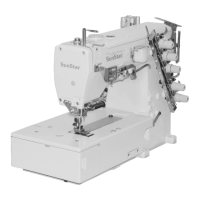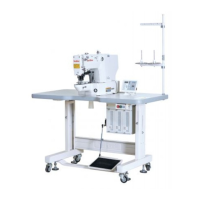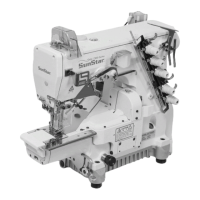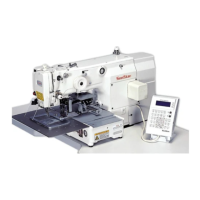24
Use the needle thread guide ③ when using stretchable
threads such as synthetic thread and the loop of needle
thread is unstable.
It is a standard setting to bring the center of the needle hole
of the needle bar take up ② against the upper side of the
needle thread guide when the needle bar is at its lowest
position.
The height of the needle bar guide can be adjusted by
loosening the screw ④.
(refer to figure 32)
[ Figure 32 ]
③
②
②
①
⑤
less
less
much
much
⑥
⑥
⑦
⑦
for woolly thread
for woolly thread
④
2) Adjustment of Top Cover Thread Tension
When [the top cover thread eyelet(Right)①] is moved up in
the X direction, the take-up volume decreases. When it is
moved down in the opposite way, the take-up volume
increases.
When an elastic thread such as woolly thread is used as the
top cover thread, loosen [the screw②] to move down [the
top cover thread eyelet (Right)①] in the Y direction. This
time make sure that the top cover thread passes through the
bottom hole as in the right figure.
[ Figure 33 ]
3) Adjustment of the Looper Thread Tension
The figure shows the looper thread take-up.
The standard setting is to place the thread holes of [the
looper thread guide⑥,⑦] at [Mark X] on [the looper thread
cast-off plate⑤].
To increase the length of loose thread, loosen the fixing
screws for [the looper thread guides⑥,⑦], and move them
forward and then fix them. To reduce the length of loose
thread, move the looper thread guides backward and fix
them.
Note :
If the looper thread’s loose thread is too long, it might cause
stitch skips. Make sure that the looper thread’s loose thread
is not too long.
When using woolly thread, move [the looper thread guides
⑥,⑦] forward to the maximum and make sure that the
thread doesn’t pass through [the supplementary tension disc
(H)].
[ Figure 34 ]
[ Figure 35 ]
Y
X
X

